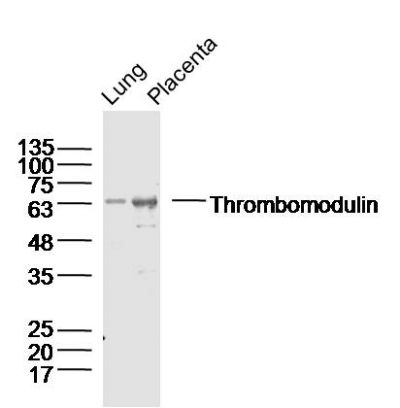产品货号 : mlR20395
英文名称 : Thrombomodulin
中文名称 : 血栓调节蛋白抗体
别 名 : Thrombomodulin; CD 141; CD141; CD141 antigen; Fetomodulin; THBD; THRM; TM; AHUS 6; AHUS6; BDCA 3; BDCA3; THPH12; TRBM_HUMAN.
研究领域 : 心血管 细胞生物 神经生物学 血管内皮细胞
抗体来源 : Rabbit
克隆类型 : Polyclonal
交叉反应 : Human, Mouse, Dog, Cow, Sheep,
产品应用 : WB=1:500-2000 ELISA=1:500-1000 IHC-P=1:400-800 IHC-F=1:400-800 ICC=1:100-500 IF=1:100-500 (石蜡切片需做抗原修复)
not yet tested in other applications.
optimal dilutions/concentrations should be determined by the end user.
分 子 量 : 61kDa
细胞定位 : 细胞膜
性 状 : Lyophilized or Liquid
浓 度 : 1mg/ml
免 疫 原 : KLH conjugated synthetic peptide derived from human Thrombomodulin:21-120/575 <Extracellular>
亚 型IgG
纯化方法 : affinity purified by Protein A
储 存 液 : Preservative: 15mM Sodium Azide, Constituents: 1% BSA, 0.01M PBS, pH 7.4
保存条件 : Store at -20 °C for one year. Avoid repeated freeze/thaw cycles. The lyophilized antibody is stable at room temperature for at least one month and for greater than a year when kept at -20°C. When reconstituted in sterile pH 7.4 0.01M PBS or diluent of antibody the antibody is stable for at least two weeks at 2-4 °C.
PubMed : PubMed
产品介绍background:
Thrombomodulin, TM is cell surface glycoprotein; plays an important role in the protein C anticoagulant pathway. It located in a vein, artery and capillary endothelial cells on the surface of plasma membrane protein. It is generally believed: TM vascular endothelial injury is an important parameter is the thrombin receptor, known in a variety of normal human tissues, can also be expressed in many tumors, TM may be similar to the E-cadherin,and is a lectin Like activity of a new class of members of the cell adhesion molecules.
CD141/Thrombomodulin is an exclusively endothelial cell surface glycoprotein that forms a 1:1 complex with thrombin. Binding of thrombin to this high-affinity receptor alters its specificity toward several substrates. The complex activates protein C approximately 1000 times faster than thrombin alone. Activated protein C degrades clotting factors V and VIII; thus, thrombomodulin converts thrombin into a physiologic anticoagulant. Thrombomodulin is also found in the circulatory and urinary systems, the physiologic significance of this is obscure.
Function:
Thrombomodulin is a specific endothelial cell receptor that forms a 1:1 stoichiometric complex with thrombin. This complex is responsible for the conversion of protein C to the activated protein C (protein Ca). Once evolved, protein Ca scissions the activated cofactors of the coagulation mechanism, factor Va and factor VIIIa, and thereby reduces the amount of thrombin generated.
Subcellular Location:
Membrane; Single-pass type I membrane protein.
Tissue Specificity:
Endothelial cells are unique in synthesizing thrombomodulin.
Post-translational modifications:
N-glycosylated.
The iron and 2-oxoglutarate dependent 3-hydroxylation of aspartate and asparagine is (R) stereospecific within EGF domains.
DISEASE:
Defects in THBD are the cause of thrombophilia due to thrombomodulin defect (THPH12) [MIM:614486]. A hemostatic disorder characterized by a tendency to thrombosis.
Defects in THBD are a cause of susceptibility to hemolytic uremic syndrome atypical type 6 (AHUS6) [MIM:612926]. An atypical form of hemolytic uremic syndrome. It is a complex genetic disease characterized by microangiopathic hemolytic anemia, thrombocytopenia, renal failure and absence of episodes of enterocolitis and diarrhea. In contrast to typical hemolytic uremic syndrome, atypical forms have a poorer prognosis, with higher death rates and frequent progression to end-stage renal disease. Note=Susceptibility to the development of atypical hemolytic uremic syndrome can be conferred by mutations in various components of or regulatory factors in the complement cascade system. Other genes may play a role in modifying the phenotype.
Similarity:
Contains 1 C-type lectin domain.
Contains 6 EGF-like domains.
SWISS:
P07204
Gene ID:
7056
Important Note:
This product as supplied is intended for research use only, not for use in human, therapeutic or diagnostic applications.
血栓调节蛋白(thrombomodulin,TM)是一种分布于静脉、动脉和毛细血管内皮细胞表面的质膜蛋白。 一般认为:TM是血管内皮损伤的重要参数,也是凝血酶的受体,已知在人类多种正常组织中表达,亦可表达于许多肿瘤组织,TM可能类似于钙粘蛋白,是具有凝集素样活性的新一类细胞粘附分子的成员。TM是血管内皮细胞膜上的凝血酶受体之一。与凝血酶结合后可降低凝血酶的凝血活性,而加强其激活蛋白C的活性。由于被激活的蛋白C具有抗凝作用,因此,TM是使凝血酶由促凝转向抗凝的重要的血管内凝血抑制因子。
产品图片












